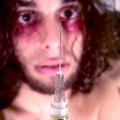The United Nations says addiction rates in war-torn Afghanistan have doubled in the past two years, to the point that nearly a million people are now using illegal drugs.
The lyrics are a prayer. A drug counselor is asking God to help end drug addiction in Afghanistan.
As he sings, about 25 men sit on cushions scattered across the floor of the drug treatment center, nodding their heads as they listen. Several of the men are in their 50s or 60s and silently stroke their beards in time to the music.
The clinic is an old two-story building with a small central courtyard. From the street the building is anonymous, just one more dilapidated house on a dusty street outside Kabul. But inside, the men are taking their first steps toward ending their addiction. Most are still using drugs but have promised to cut back. Within a week, they will try to stop entirely.
Upstairs, 43-year-old Abdul Jalil is in the second stage of recovery. He stopped taking drugs several days ago, and is going through the painful process of withdrawal. As he speaks, he wraps his arms around his stomach and leans forward slowly until he is almost doubled over.
He says he started abusing drugs more than 20 years ago, during the Soviet Union's invasion of Afghanistan. Like so many other men here at the clinic, he says he began smoking hashish after he lost his job and could not find new work. Soon he was experimenting with tiny bits of opium. Within months, he says, he was a heroin addict, injecting himself with the opium derivative several times a day.
According to a recent United Nations survey, there are nearly a million drug abusers in Afghanistan today. Almost 200,000 of them are hard-core opium and heroin addicts.
Dr. Tariq Suliman runs the Nejat Center in Kabul, where Jalil is recovering. He says addiction rates throughout the country are higher now than ever before.
He says the number of female addicts, in particular, is on the rise. More than 100,000 women addicts were identified in the U.N. survey, but he says the real number could be several times higher.
Like the men, many of the women started taking drugs while living in refugee camps in neighboring Pakistan or Iran during the war against the Soviet Union, or the subsequent civil war. For thousands of these refugees, he says, drugs were one of the only ways to relieve the pain and frustration of camp life.
Today, Suliman says, Afghanistan's grinding poverty and massive illegal drug trade are creating a new generation of addicts, male and female. The country produces an estimated 90 percent of the world's illegal opium, and the drug is readily available in almost every town and city throughout the country. When the strict Islamist Taleban group controlled the country in the late 1990s, it used draconian measures to cut the opium crop sharply. But since the Taleban's overthrow in 2001, impoverished farmers have returned to growing the lucrative opium. The international community has committed millions of dollars to help Afghanistan fight opium production. But Suliman says funding to help drug addicts like Jalil is almost non-existent.
He says his clinic only has room for 20 live-in patients. Another 20 take part in an out-patient program. In the entire country, he says, there are only three other drug centers, with fewer than 100 beds among them.
For women the situation is even worse. The clinics are all reserved for men out of deference to Afghanistan's conservative social customs. Female addicts can only receive treatment in their own homes, and without the benefit of support groups.
The Afghan government says it plans to build at least five new clinics around the country. But so far, funding is short, and construction has yet to begin. For now the focus is on prevention. The U.N. is helping train local health workers and funds public awareness campaigns in an effort to limit the number of new addicts.
Back at the Nejat Center, the patients say they know just how lucky they are to have at least a chance of recovery.
As the day patients play music to pass the time, several of the men jump to their feet and start dancing.
Upstairs, Abdul Jalil says he can feel the drugs leaving his body. He says that in a few days, he should be healthy enough to go home and see his family. If he is lucky, he says, he will find a job.

